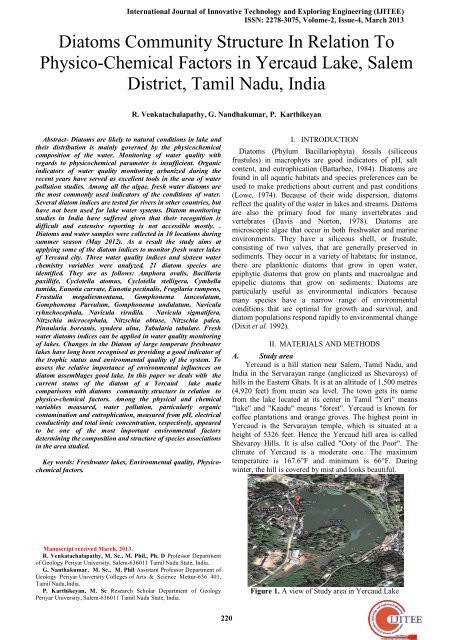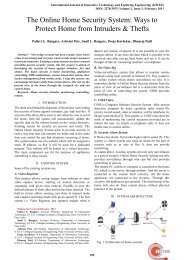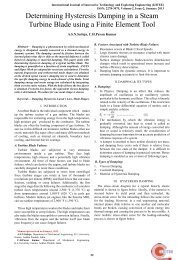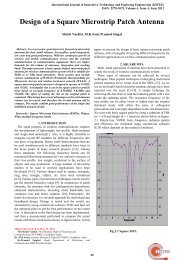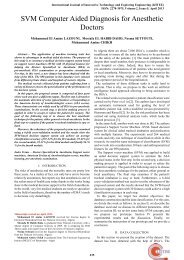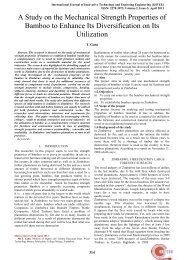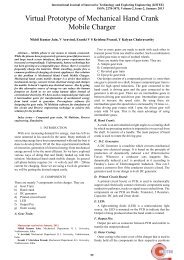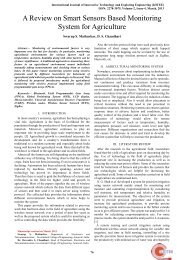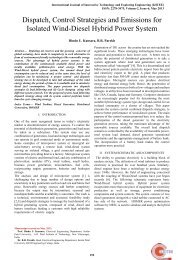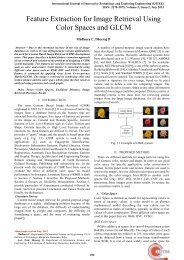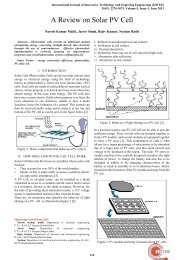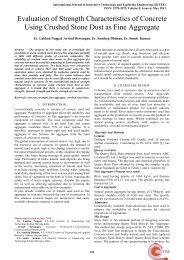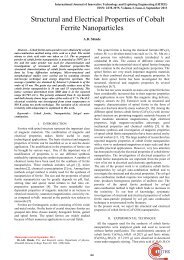Diatoms Community Structure In Relation To Physico-Chemical ...
Diatoms Community Structure In Relation To Physico-Chemical ...
Diatoms Community Structure In Relation To Physico-Chemical ...
Create successful ePaper yourself
Turn your PDF publications into a flip-book with our unique Google optimized e-Paper software.
<strong>Diatoms</strong> <strong>Community</strong> <strong>Structure</strong> <strong>In</strong> <strong>Relation</strong> <strong>To</strong> <strong>Physico</strong>-<strong>Chemical</strong> Factors in Yercaud Lake, Salem District,Tamil Nadu, <strong>In</strong>diaB. GeographyThe range Yercaud situated is Archaeon plutonic rocksof charnokite series and these have weathered into therugged masses of hills. There are three routes up to the hills,the Shevaroys range is covered with green grasses, and hasnot any considerable growth of forests.C. ClimateThe climate of Yercaud is moderate. Winters are fairlymild, starting in September and ending in December. Duringwinter, the hills are covered in mist. Winters range from12°C to 25°C, and Summers from 16°C to 30°C. Rainfall is1500–2000 mm. The coffee bushes blossom in April andoffer a spectacular view. The climate is also particularlypleasant.A total of ten samples are collected from the lake sites.These sites were located in from different part of the lakelike water inlet, outlet, middle and surrounding parts of theisland with the help paddle boats. <strong>Diatoms</strong> samples arecollected from the macrophytes and lake water. After initialobservation, materials are fixed in Formalin solution (0.5%)to immobilize the cells. Each sample is assigned with avoucher number along with the collection.D. Laboratory analysisSub-samples of the diatom suspensions were cleaned toremove organic material using wet combustion withconcentrated HNO 3 and cleaned using 30% H 2 O 2 mountedin Naphrax (Stoermer et al., 1995). Identification of diatomswas carried out using taxonomic guides (Gandhi, 19571959a, 1959b, 1961, 1962, 1967; Karthick et al., 2008). Thefinal 'cleared' diatom samples – an ash coloured material ismounted in a mounting medium e.g. Napthrax with arefractive index close to 1.7 and placed on a hotplate untilthe solvent in the medium evaporates. The slide is cooledimmediately, by removing from the hotplate. The diatomslide thus obtained is permanent. The diatoms cleaned cellsin permanent slides are observed under 40X andphotographed using black and white for best results or bydigital photography. The water samples are analyzed byTamilnadu water supply and drainage board district watertesting laboratory in Salem.E. Species Distribution<strong>Diatoms</strong> are unicellular phytoplankton with cell wallsmade of silica. They lived in both fresh water and saltwater.<strong>Diatoms</strong> are a type of algae. Their cell walls are made ofsilica (glass) This unique structure preserves their shape, andmakes them excellent species to study the condition of lakesover time. The presence or absence of certain diatoms canhelp us understand the history of the particular lake.From the 10 samples collected and analyzed in the studyarea, a total number of 21 diatom species are identified.They are as follows: Amphora ovalis, Bacillaria paxillife,Cyclotella atomus, Cyclotella stelligera, Cymbella tumida,Eunotia curvate, Eunotia pectinalis, Fragilaria rumpens,Frustulia megaliesmontana, Gomphonema lanceolatum,Gomphonema Parvulum, Gomphonema undulatum,Navicula ryhnchocephala, Navicula virudila. Naviculasigmatifera, Nitzschia microcephala, Nitzschia obtuse,Nitzschia palea, Pinnularia boreanis, syndera ulna, Tabulariatabulate.III. RESULT AND DISCUSSIONAmong the species found in the study area, the speciesbelong to genera Navicula, Gomphonema, Nitzcshia,Pinnularia are reported and associated with relatively cleanto less polluted waters. The Similar results were reported byRound (1991) from Brazil; Biggs and Kilroy (2000) fromNew Zealand; Potapova and Charles (2003) from US rivers.These species are reported from less polluted, tolerant andassociated with natural substrates i.e. Macrophytes. Thespecies such as Navicula sigmatifera, Navicula virudila andGomphonema undulatum, Pinnularia boreanis are mostdominant species and associated with relatively clean to lesspollute water i.e.Yercaud lake.However, the species like Nitzschia palea, Gomphonemaparvulum are found to be tolerant of organic pollution tosewage effluent effect at lake inlet. Gomphonema parvulumoccurs as dominant species in polluted in lake. This may bebecause of discharge of effluents and untreated sewage intothe lake. Abundance and diversity of species such asNavicula sigmatifera and Navicula virudila indicate that themiddle and outlet portion of the lake.IV. CONCLUSIONAmong the physical and chemical variables measured,water pollution, particularly organic contamination andeutrophication, determined from pH, electrical conductivityand concentration ionic, respectively, were the mostimportant environmental factors determining thecomposition and structure of the species associations in thestudy area. It may be concluded that the density diatom isdefendant on abiotic factor either directly are indirectly.Diatom communities and the use of diatom indices yieldsignificant results in lake water quality monitoring in <strong>In</strong>dia.It can be concluded that, although the lakes are at a widedistance apart, many diatom communities in them havesimilar environmental tolerances. Water chemistry variablesare closely related to diatom indices, which is an indicationthat diatoms can be used as indicators of organic andanthropogenic pollution. <strong>In</strong> order to achieve this,identification and preparation of taxonomic list of diatomflora of <strong>In</strong>dian waters needs to be stressed.V. ACKNOWLEDGEMENTThe authors are expressing their sincere thanks to PeriyarUniversity for all the supports rendered to carry out theinvestigation at Advanced Micropaleontology Lab.REFERENCES[1] Biggs BJE., Kilroy C. 2000. Stream periphyton monitoring manual,New Zealand; NIWA: 226p.[2] John J. 1981. New Species of freshwater diatoms from WesternAustralia. Nova Hedwigia 34: 569-576.[3] John J. 1993. The use of diatoms in monitoring the development ofcreated Wetland at RGC mine site, Capel, Western Australia,Hydrobiologia 269/270:427-436.[4] Potapova M., Charles D.F. 2003. Distribution of benthic diatoms inU.S. Rivers in relation to conductivity and ionic composition.Freshwater Biology 48 (2):1311-1328[5] Round FE. 1991. <strong>Diatoms</strong> in river water monitoring studied. Journalof Applied Phycology 3(1): 129-145.[6] Dixit, S.S., J.P. Smol, J.C. Kingston, and D.F. Charles. 1992.<strong>Diatoms</strong>: powerful indicators of environmental change.Environmental Science and Technology 26 (1): 22-33.[7] Battarbee, R., 1984, Diatom analysis and the acidification of lakes:Phil. Trans. R. soc., Ser. B. v.305, p. 451-477.[8] Lowe, R., 1974, Environmental requirements and pollution toleranceof freshwater diatoms: Natural Environmental Research Center Officeof Research and Development U.S. Environmental ProtectionAgency, EPA 670/4-74-005. p. 334.[9] Davis, R., Norton, S., 1978, Paleolimnologic studies of human impacton lakes in the United States, with emphasis on recent research inNew England: Pol. Arch. Hydrobiol. v.25, p. 99-115.221
<strong>In</strong>ternational Journal of <strong>In</strong>novative Technology and Exploring Engineering (IJITEE)ISSN: 2278-3075, Volume-2, Issue-4, March 2013The physicochemical analysis of samples from inlet, outlet, middleof the lake is given below:Parameters/ Locations Outlet <strong>In</strong>let MiddleOdour Earthy Algae AlgaeTurbidity NT UNITS 16 12 15TDS mg/ lit 179 186 188Ec micromoho/cm 256 266 269pH 7.55 7.46 7.38<strong>To</strong>tal alkalinity 108 116 120<strong>To</strong>tal hardness 96 104 112Calcium 19 21 21Magnesium 8 9 9Sodium 21 23 23Potassium 2 2 2Iron 0.5 0.3 0.5Nitrate 1 1 1Chloride 16 16 16Fluoride 0.2 0.2 0.2Sulphate 1 1 1R. Venkatachalapathy, M. Sc., M. Phil., Ph. D Professor Department ofGeology Periyar University, Salem-636011 Tamil Nadu State, <strong>In</strong>dia.G. Nanthakumar, M. Sc., M. Phil Assistant Professor Department ofGeology Periyar University Colleges of Arts & Science Mettur-636 401,Tamil Nadu,<strong>In</strong>dia.Table 1. Physical and chemical parameters in Yercaud lakePlate 1P. Karthikeyan, M. Sc Research Scholar Department of Geology PeriyarUniversity, Salem-636011 Tamil Nadu State, <strong>In</strong>dia.1. Amphora ovalis, 2. Bacillaria paxillifer, 3. Cyclotella atomus, 4.Cyclotella stelligera, 5. Cymbella tumida, 6. Eunotia curvate, 7.Eunotia pectinalis, 8. Fragilaria rumpens, 9. Frustuliamegaliesmontana, 10. Gomphonema lanceolatum, 11.Gomphonema Parvulum, 12. Gomphonema undulatum, 13.Navicula ryhnchocephala, 14. Navicula virudila. (40X)Plate 215. Navicula sigmatifera, 16. Nitzschia microcephala, 17. Nitzschiaobtuse, 18. Nitzschia palea, 19. Pinnularia boreanis, 20. synderaulna, 21. Tabularia tabulate. (40X)222


